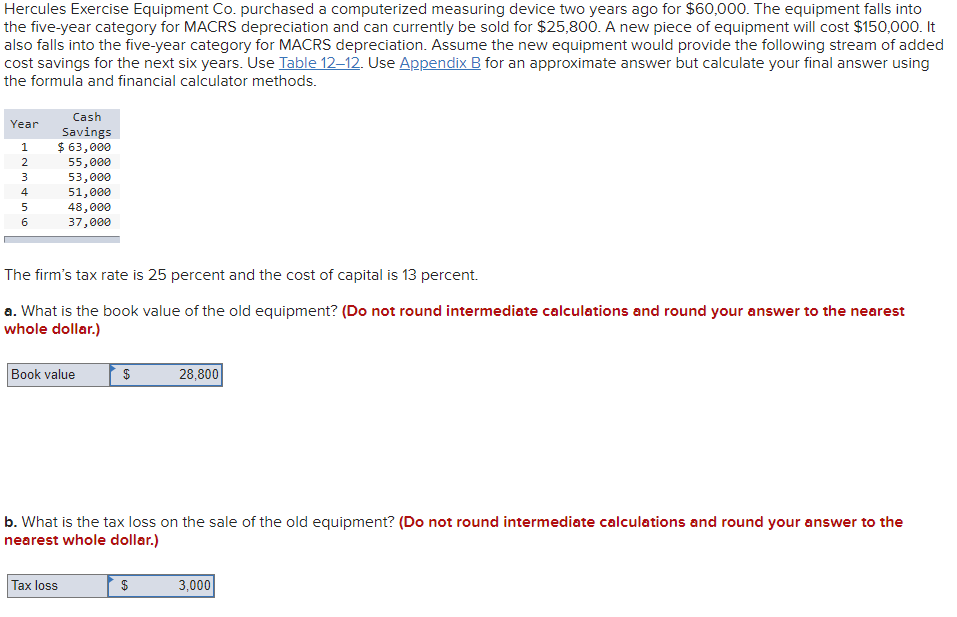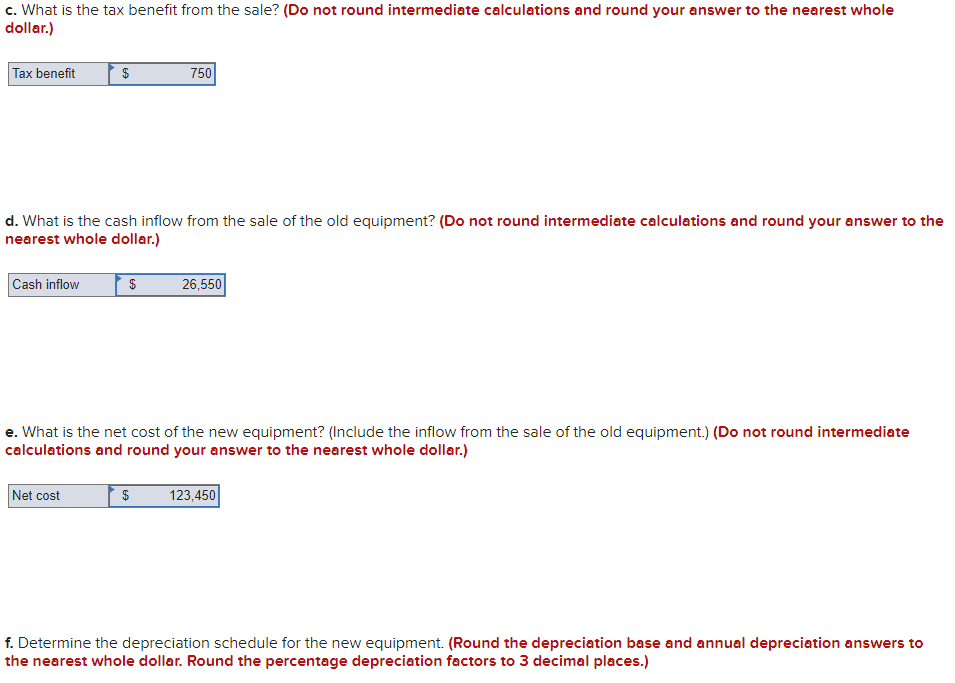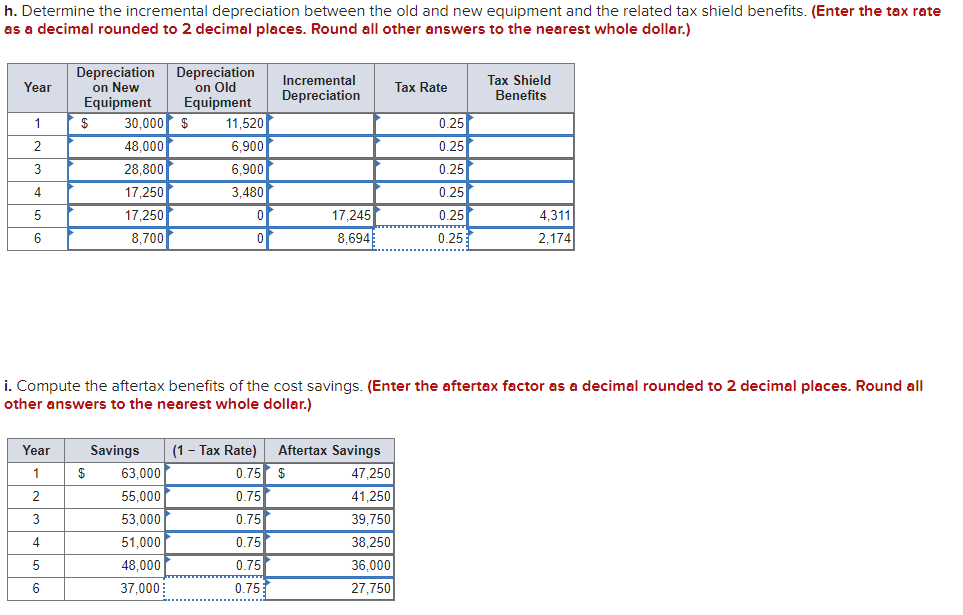Answered step by step
Verified Expert Solution
Question
1 Approved Answer
I ONLY NEED ANSWERS FOR H, I, J-1, J-2, K-1 THANK YOU!!! Hercules Exercise Equipment Co. purchased a computerized measuring device two years ago for





I ONLY NEED ANSWERS FOR H, I, J-1, J-2, K-1
THANK YOU!!!
Hercules Exercise Equipment Co. purchased a computerized measuring device two years ago for $60,000. The equipment falls into the five-year category for MACRS depreciation and can currently be sold for $25,800. A new piece of equipment will cost $150,000. It also falls into the five-year category for MACRS depreciation. Assume the new equipment would provide the following stream of added cost savings for the next six years. Use Table 1212. Use Appendix B for an approximate answer but calculate your final answer using the formula and financial calculator methods. Year 1 2 3 4 5 6 Cash Savings $ 63,000 55,000 53,000 51,000 48,000 37,000 The firm's tax rate is 25 percent and the cost of capital is 13 percent. a. What is the book value of the old equipment? (Do not round intermediate calculations and round your answer to the nearest whole dollar.) Book value $ 28,800 b. What is the tax loss on the sale of the old equipment? (Do not round intermediate calculations and round your answer to the nearest whole dollar.) Tax loss $ 3,000 c. What is the tax benefit from the sale? (Do not round intermediate calculations and round your answer to the nearest whole dollar.) Tax benefit $ 750 d. What is the cash inflow from the sale of the old equipment? (Do not round intermediate calculations and round your answer to the nearest whole dollar.) Cash inflow $ 26,550 e. What is the net cost of the new equipment? (Include the inflow from the sale of the old equipment.) (Do not round intermediate calculations and round your answer to the nearest whole dollar.) Net cost $ 123,450 f. Determine the depreciation schedule for the new equipment. (Round the depreciation base and annual depreciation answers to the nearest whole dollar. Round the percentage depreciation factors to 3 decimal places.) Year 1 2 3 Depreciation Base $ 150,000 150,000 150,000 150,000 150,000 150,000 Percentage Annual Depreciation Depreciation 0.200 $ 30,000 0.320 48,000 0.192 28,800 0.115 17,250 0.115 17,250 0.058 8,700 $ 150,000 4 5 6 g. Determine the depreciation schedule for the remaining years of the old equipment. (Round the depreciation base and annual depreciation answers to the nearest whole dollar. Round the percentage depreciation factors to 3 decimal places.) Year 1 2 Depreciation Base $ 60,000 60,000 60,000 60,000 Percentage Annual Depreciation Depreciation 0.192 $ 11,520 0.115 6,900 0.115 6,900 0.058 3,480 3 4 h. Determine the incremental depreciation between the old and new equipment and the related tax shield benefits. (Enter the tax rate as a decimal rounded to 2 decimal places. Round all other answers to the nearest whole dollar.) Year Incremental Depreciation Tax Rate Tax Shield Benefits 1 2 3 Depreciation Depreciation on New on Old Equipment Equipment $ 30,000 $ 11,520 48,000 6,900 28,800 6.900 17,250 3,480 17,250 0 8,700 0 0.25 0.25 0.251 0.25 0.25 0.25 4 5 4.311 17,245 8,694 6 2,1741 i. Compute the aftertax benefits of the cost savings. (Enter the aftertax factor as a decimal rounded to 2 decimal places. Round all other answers to the nearest whole dollar.) Year Savings 63,000 1 2 55,000 3 53,000 51,000 48.000 37,000 (1 - Tax Rate) Aftertax Savings 0.75 $ 47.250 0.75 41,250 0.75 39.750 0.75 38,250 36.000 0.75 27,750 .... 4 0.751 5 6 j-1. Add the depreciation tax shield benefits and the aftertax cost savings to determine the total annual benefits. (Do not round intermediate calculations and round your answers to the nearest whole dollar.) Year Tax Shield Benefits from Depreciation Aftertax Cost Savings Total Annual Benefits 1 2 3 47,250 41,250 39,750 38,250 36,000 27,750 4 5 6 4,311 2,174 40,311 29,924 j-2. Compute the present value of the total annual benefits. (Do not round intermediate calculations and round your answer to the nearest whole dollar.) Present value k-1. Compare the present value of the incremental benefits (j) to the net cost of the new equipment (e) (Do not round intermediate calculations. Negative amount should be indicated by a minus sign. Round your answer to the nearest whole dollar.) Net present valueStep by Step Solution
There are 3 Steps involved in it
Step: 1

Get Instant Access to Expert-Tailored Solutions
See step-by-step solutions with expert insights and AI powered tools for academic success
Step: 2

Step: 3

Ace Your Homework with AI
Get the answers you need in no time with our AI-driven, step-by-step assistance
Get Started


